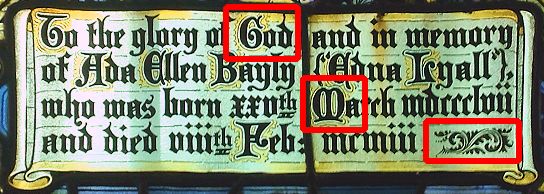|
Look at the bottom of this page for a comparison of two windows.
Charles Eamer Kempe Biography
Charles Eamer Kempe (29 June 1837 - 29 April 1907) was a Victorian stained glass designer and manufacturer. His studios produced over 4,000 windows and also designs for altars and altar frontals, furniture and furnishings, lichgates and memorials that helped to define a later nineteenth century Anglican style. The list of English cathedrals containing examples of his work includes: Chester, Gloucester, Hereford, Lichfield, Wells, Winchester and York.
Early Life
Charles Kempe was born at Ovingdean Hall, near Brighton, East Sussex in 1837. He was the youngest son of Nathaniel Kemp, a cousin of the Thomas Read Kemp, a politician and property developer responsible for the Kemptown area of Brighton and the maternal grandson of Sir John Eamer, who served as Lord Mayor of London in 1801.
After attending Twyford School, he attended Pembroke College, Oxford where he was influenced by the Anglo-Catholic Tractarian revival and considered a vocation to the priesthood. When it became clear that his severe stammer would be an impediment to preaching Kempe decided that "if I was not permitted to minister in the Sanctuary I would use my talents to adorn it", and subsequently went to study architecture with the firm of a leading ecclesiastical architect George Frederick Bodley, where he learned the aesthetic principles of medieval church art particularly stained glass.
Kempe Studios
In 1866 he opened a studio of his own in London, supplying and creating stained glass and furnishings and vestments. The firm prospered and by 1899 he had over fifty employees. The mid-Victorian period were important years in the history of the design of English churches and Kempe’s influence is found in numerous examples, many in his home county of Sussex which has 116 examples of his work. The works at St Mark’s, Staplefield near Horsham, West Sussex dating from 1869 are regarded as especially important, representing the earliest of three known examples of Kempe’s wall painting. They contain key elements of Kempe’s figurative work. The angels holding the scroll are magnificently apparelled and the borders of their cloaks are embellished with pearls, each individually highlighted although they do not contain a design of peacock feathers, a well used embellishment in later works.
On Kempe’s death in 1907 the firm passed to his relative, Walter Earnest Tower (1873 -1955), who renamed the firm C. E Kempe and Co. A lack of orders caused by the Great Depression ended the firm's life in 1934.
Personal life
Kempe was a rather shy person, who never married. He continued to live in Sussex most of his life and in 1875 he bought and renovated an Elizabethan House at Lindfield, near Haywards Heath in West Sussex. Kempe would entertain his clients and professional colleagues from his home enjoying the role of a country squire.
Kempe died suddenly in April 1907 aged 69, at 28 Nottingham Place, London, having caught a cold that led to congestion of the lung and refused to get medical help. He is buried in the churchyard at St Wulfran's Church, Ovingdean. Unfortunately, most of Kempe's records were disposed of after the firm shut in 1934.
Source: Wikipedia
Comparison of Willem's dedication window in Florida with a Charles Kempe window in Marton.

Dedication window in memory of Ada Ellen Bayly. Produced by Kempe, which was
originally installed in the St Peter's church in Eastbourne in 1906. Now in Florida.

Dedication window in memory of Margaret Bolckow by C. E Kempe and Co.,
installed in St Cuthbert's Church, Marton, Middlesbrough in 1908. (Ref.)